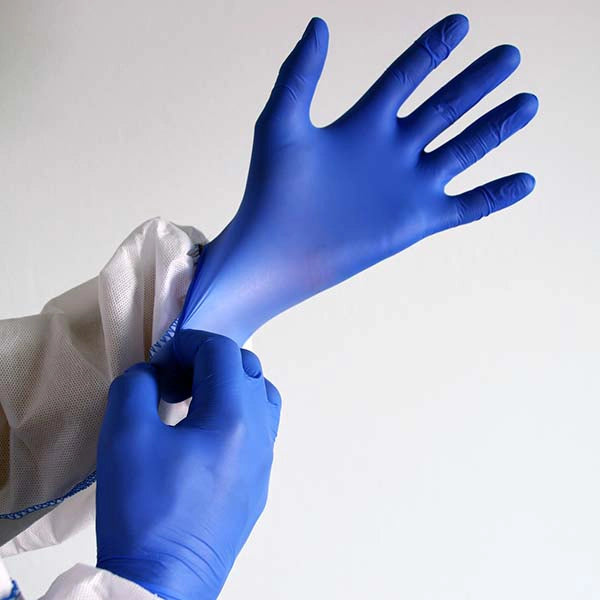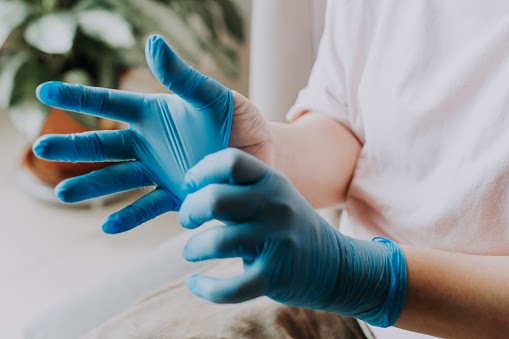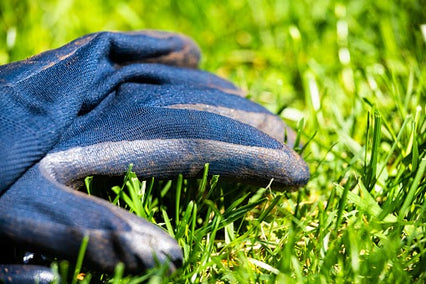Once you’ve figured out the right material for your glove, you’re ready for the next most important component: finding the right size glove.
Of course, if you’re like many glove buyers, you’re probably thinking that numbered sizes offer all the information you need. In reality, if you’re looking for gloves that fit perfectly, you’ll need to go a little deeper.
And trust us: if you’re looking for gloves that get the job done right, finding the right size glove is worth the extra time.
Here’s a look at why glove sizing is so important and how to measure for the right glove.
Are All Nitrile Gloves The Same Size?
No, not all nitrile gloves are the same size. Nitrile gloves come in various sizes to accommodate different hand shapes and sizes, ensuring a proper fit for every user. They are typically available in a range of sizes, including small, medium, large, and extra-large. Some brands may even offer additional sizes to cater to more specific needs.
The right glove size is crucial for comfort, dexterity, and safety. Gloves that are too small can be tight and uncomfortable, restricting movement and potentially tearing more easily. On the other hand, gloves that are too large can slip off or bunch up, reducing tactile sensitivity and increasing the risk of contamination.
To ensure the best performance and protection, it’s important to select the correct size of nitrile gloves. This not only enhances comfort but also allows for better control and precision during use. Properly fitting gloves help maintain a secure barrier against contaminants, making them essential for tasks that require high levels of hygiene and safety.
How To Size Nitrile Gloves
Here’s the good news: finding the right size gloves is a matter of knowing how to measure. A basic pair of gloves can be found with one hand measurement, though if you want truly well-fitted gloves, there are a few other measurements worth including.
How to Measure Your Hand for Gloves:
1. Hand Circumference: Measure around the widest part of your hand (excluding the thumb) with a tape measure.
2. Hand Length: Measure from the tip of your middle finger to the base of your palm.
Gloves are generally sized based on the width of your hand, so if you don’t measure anything else, measure your hand width. To do this, simply find a tape measure and measure all the way around the widest part of your hand (excluding your thumb). The result, in inches, is your glove size. Here’s how it breaks down in US sizing:
- 6-7 Inches: XS
- 7-8 Inches: S
- 8-9 Inches: M
- 9-10 Inches: L
- 10-11 Inches: XL
- 11 + Inches: XXL
For more precise measurements, you should also measure your finger length. To do this, measure from the bottom of your palm (at the crease of your wrist) all the way up to the tip of your middle finger. This translates as follows:
- 6 5/16 Inches: XS
- 6 3/4 Inches: S
- 7 3/16 Inches: M
- 7 9/16 Inches: L
- 8 1/16 Inches: XL
- 8 7/16 + Inches: XXL
You can also measure the length of your index finger, but generally, measuring your middle finger will give you a glove that fits your hand at its longest point.
Glove Sizes for Men
| Glove Size | Hand Circumference (inches) | Hand Length (inches) |
| Small | 7-8 | 6.5-7 |
| Medium | 8-9 | 7-7.5 |
| Large | 9-10 | 7.5-8 |
| X-Large | 10-11 | 8-8.5 |
| XX-Large | 11-12 | 8.5-9 |
Glove Sizes for Women
| Glove Size | Hand Circumference (inches) | Hand Length (inches) |
| Small | 6-6.5 | 6-6.5 |
| Medium | 6.5-7 | 6.5-7 |
| Large | 7-7.5 | 7-7.5 |
| X-Large | 7.5-8 | 7.5-8 |
What’s Most Important in Glove Sizes
For some glove buyers, length and width don’t translate to a perfect match. If that’s the case for you, choose a glove that fits the length of your hand rather than the width, even if that means a smaller size than your recommended width. Remember, fingers that are too long can get caught in tools and machines and compromise your tactile sensitivity.
Some glove buyers also have thick fingers or muscular hands. You may be tempted to go a size up, but you should instead look for gloves that stretch. That way, you won’t compromise your grip or dexterity with a glove that’s too loose. Look for a glove with a loose cuff, as this will make application and removal much easier.
Why Proper Sizing is Essential
Remember the expression “fits like a glove”? A good pair of work gloves fit snugly but comfortably, without any extra space for slippage that would compromise your grip, tactile sensitivity, or dexterity.
But in order to find the right fit, you need to find gloves that are the right size.
It doesn’t matter how a glove is designed to fit--if it’s not designed to fit a hand your size, it will never go on the way it’s supposed to and will never give you the right level of performance.
This is true of disposable gloves just as much as any pair of reusable gloves, especially if you count on your disposable glove for tasks requiring dexterity and tactile sensitivity. Doctors and surgeons, for example, need their gloves to fit perfectly so that they can do precise work.
Of course, glove sizing is also a safety issue. For industrial workers, for example, a glove that doesn’t fit can easily get caught in machinery or tools, potentially endangering the worker’s entire hand. Picture trying to work with moving parts while wearing gloves that have too much room in the fingers and you can understand why.
The one exception to sizing is when you’re looking for gloves to provide a basic sanitary barrier, such as basic food prep. However, even in this case, you still need a glove that’s the right size. Looseness is fine for a basic sanitary barrier, but if the glove is too big, it will get in your way anytime you try to handle utensils.
Comfort and Fit
Gloves that fit well are more comfortable to wear for extended periods. Ill-fitting gloves can cause discomfort, chafing, and even hand fatigue. Properly sized gloves conform to the hand’s shape, providing a snug yet comfortable fit.
Safety
Gloves that are too loose can slip off or bunch up, increasing the risk of contamination and reducing the effectiveness of the protective barrier. Conversely, gloves that are too tight are more likely to tear or puncture, compromising protection. Ensuring the correct size helps maintain the integrity of the glove’s barrier function.
Glove Sizes to Fit Every Hand Perfectly
Once you know how to find your glove size, it’s that much easier to choose a pair of nitrile gloves that fit your hand perfectly. That way, you can focus on what matters: getting the job done right every single time.
Ready to shop for a reliable pair of nitrile gloves? Check out our selection of nitrile gloves today (and the rest of our store selection too!)
Nitrile Glove Sizing: Frequently Asked Questions
How do you calculate glove size?
To calculate your glove size, measure the circumference of your hand around the widest part of your palm, excluding the thumb, using a tape measure. The measurement in inches will correspond to your glove size. For example, if your hand circumference measures 8 inches, you would typically wear a size 8 glove.
How do I know my disposable glove size?
To determine your disposable glove size, first measure the circumference of your hand around the widest part of your palm, excluding the thumb. Then, measure the length from the tip of your middle finger to the base of your palm. Compare these measurements to a glove sizing chart to find the best fit. Disposable gloves are often sized as small, medium, large, or extra-large based on these measurements.
What is glove size based on?
Glove size is based on the circumference and length of your hand. The circumference is measured around the widest part of your palm, excluding the thumb, while the length is measured from the tip of your middle finger to the base of your palm. These measurements help determine the appropriate glove size to ensure a comfortable and secure fit.






